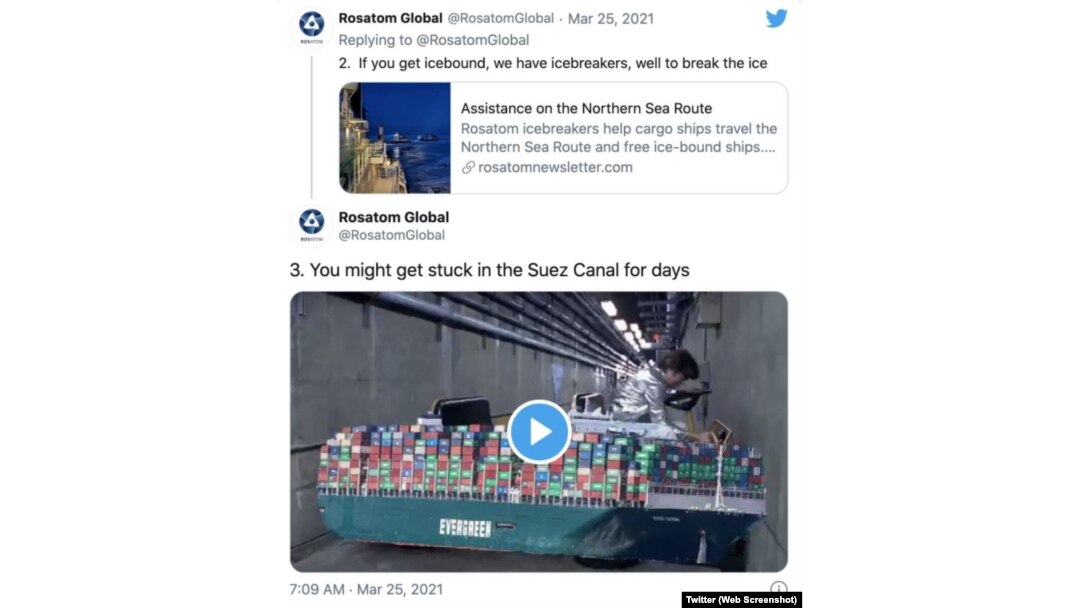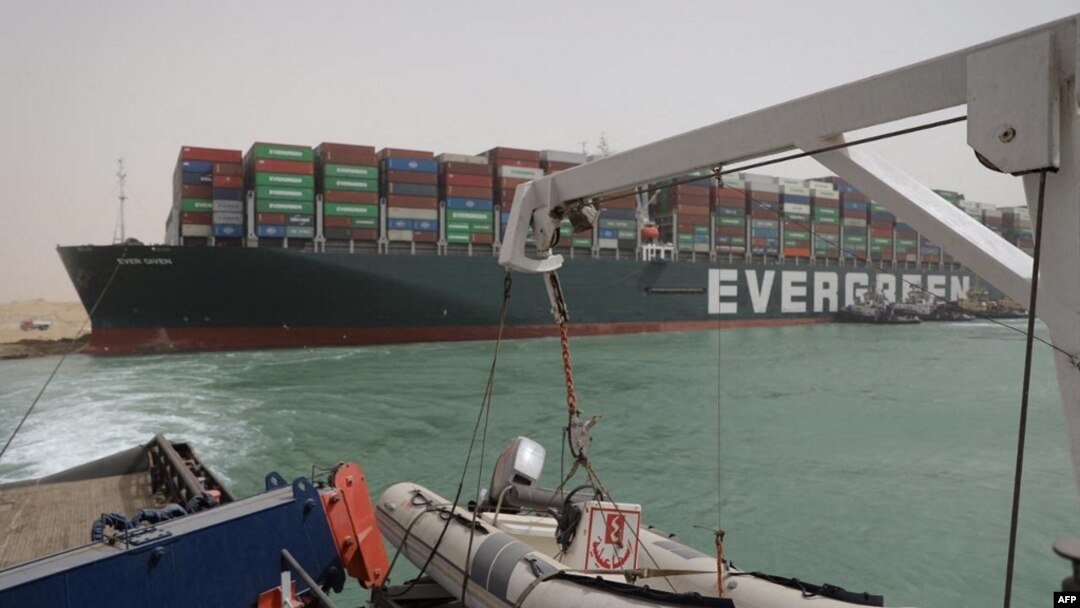Last week, as the gargantuan container ship Ever Given stood wedged in the Suez Canal, blocking the artery carrying around 15 percent of the world's cargo ship trade and giving the global economy palpitations, the state company that runs Russia's Arctic icebreakers had a different reaction: mockery.
In a series of posts to Twitter that were later taken down, Rosatom poked fun at the blocked canal, promoted its newsletter, and suggested that the Arctic provided more space to "draw peculiar pictures" -- as it linked to a marine tracking site that appeared to show the Ever Given forming a giant penis in the Red Sea just before entering the canal.

A screen shot of one of several Twitter posts dated March 25 by the Russian state company overseeing the country’s Arctic icebreaker fleet. The posts, which appeared to make fun of the cargo ship that got stuck in the Suez Canal, were later taken down.
And as dredgers and tugboats neared success in freeing the Ever Given, Russia's Energy Ministry joined the publicity push.
"The Northern Sea Route…has a high potential for expanding the volume of cargo transportation, allowing to significantly reduce the time for transporting goods from Asia to Europe," the ministry said on March 29.
With the resumption of Suez traffic, the crisis in global shipping abated, as did the urgency for finding alternative routes. Still, for Russia, the promise of its Arctic seaway -- known as the Northern Sea Route -- is sky-high, a viable shipping alternative that could garner millions in revenues and also help develop infrastructure in the remote shoreline regions.
The question is when.
"At best, it is very much into the future," Ulf Sverdrup, director of the Norwegian Institute of International Affairs, told RFE/RL. "It's not an easy switch from the Suez to the Northern Sea Route."
The Suez Canal, along with other major routes such as the Panama Canal in Central America and the Straits of Malacca, between Malaysia and Indonesia, have become chokepoints as container ships have grown in size and costs have plummeted. But they're still the most economical ways to ship goods across the globe.
More than 370 ships were poised to traverse the Suez on March 29 and the following day, according to maritime traffic monitors. And between 18,000 and 20,000 ships annually travel from the Red Sea to the Mediterranean via the Suez.
By comparison, last year, only a few dozen ships transited the entire Northern Sea Route, according to the Center for High North Logistics at Norway's Nord University Business School. Still, the tally -- 62-- was nearly double that of 2019.
The Energy Ministry has said cargo traffic on the route was 33 million metric tons in 2020, up from around 11 million tons in 2017, and that amount "has a great potential for expanding." The Suez handles an estimated 3 million metric tons a day.
Russian nuclear-powered icebreaker Arktika undergoes sea trials in the Baltic Sea in July 2020.
The entire Northern Sea Route shortens the journey of a ship traveling from East Asia to European ports by about 4,000 nautical miles (7,500 kilometers), compared with the Suez route.
Jan-Gunnar Winther, director of the Norwegian Center for the Ocean and the Arctic, told RFE/RL that the Russians were very optimistic about prospects for the Northern Sea Route; Europeans less so. China also has long-term plans for access to the route.
Arctic Priorities
President Vladimir Putin's Kremlin has made development of the Russian Arctic a strategic priority, in part because of climate change that has made access to the region less forbidding. In 2018, he issued a decree ordering an increase in northern cargo traffic to 80 million metric tons by 2024, though it's unclear where exactly that increase would come from.
The decree also transferred oversight of the route to Rosatom, the state-run corporation that oversees Russia's ice-breaking fleet as well as its atomic energy industry.
In 2020, the Russian government approved an incentive program involving tax breaks and other subsidies worth over $300 billion for developing infrastructure, including industrial projects, LNG facilities, and oil and gas extraction projects.
Major companies controlled by or closely tied to the state, such as oil giant Rosneft, gas producer Gazprom, and metals miner Nornickel, are also building out elements of infrastructure, aimed at boosting natural resource exports.
The Kremlin has also backed a major liquefied-natural-gas facility, built by Novatek -- which is the country's largest independent gas producer and is controlled by a close Putin ally -- on the Yamal Peninsula.
The plant, and another one scheduled to come online in the coming years, are sophisticated, industrial facilities, said Winther -- an indication of the Kremlin's emphasis on bringing in more oil-and-gas revenues to government coffers.
The LNG projects also include a push to build new commercial ships that are capable of sailing in icy waters, with hardened hulls, but are not outright icebreakers, Winther said.
"The Suez precedent has shown how fragile any route between Europe and Asia is. Therefore, the development of alternative routes is essential to guarantee sustainable international navigation.," Vladimir Panov, a top Rosatom official was quoted by the Interfax news agency as saying on March 25. "This increases the role of the Northern Sea Route, which has been ever more competitive from year to year."
The problem is that the route is still more expensive, experts said. For example, icebreakers are still required to escort ships, an expensive additional cost. Russia has invested heavily in icebreakers, and now has the world's largest fleet, including powerful nuclear-powered ships. The fleet is overseen and managed by Rosatom.
WATCH: A promotional video by Rosatom, the state company that runs Russia's Arctic icebreakers:
Cargo ships transiting the Arctic route will be expected to buy insurance as part of the transit passage, as well as utilize local supply ships and ports adding further costs.
Currently the route is completely ice-free only a couple months out of the year. The Energy Ministry said in its March 29 statement that the route was ice-free in 2020 for nine to 10 months.
Russia's meteorological agency, Rosgidromet, said last year that Arctic ice cover had reached a record low, and officials predict that the route will be ice-free at the earliest by 2025.
But traveling in Arctic waters, ice or no ice, also requires strengthened hulls to protect ships against challenging sea conditions. That would require a substantial investment by shipping fleets.
There's also the issue of high-speed communications, specifically a lack of broadband access, Winther said. Russia will need to build out communications infrastructure -- satellites, for example, or relay towers -- that ship captains could rely on for data about ice conditions.
"Once these series of bottlenecks are taken away, or eased up, it's really not impossible from the climate perspective, with darkness and ice, to foresee much more travel, not just on the [Northern Sea Route]," he said, but also via trans-Polar routes -- traveling across the top of the globe, across the North Pole.
"Regardless of the Suez, we will see the development of the Northern Sea Route," he said.


